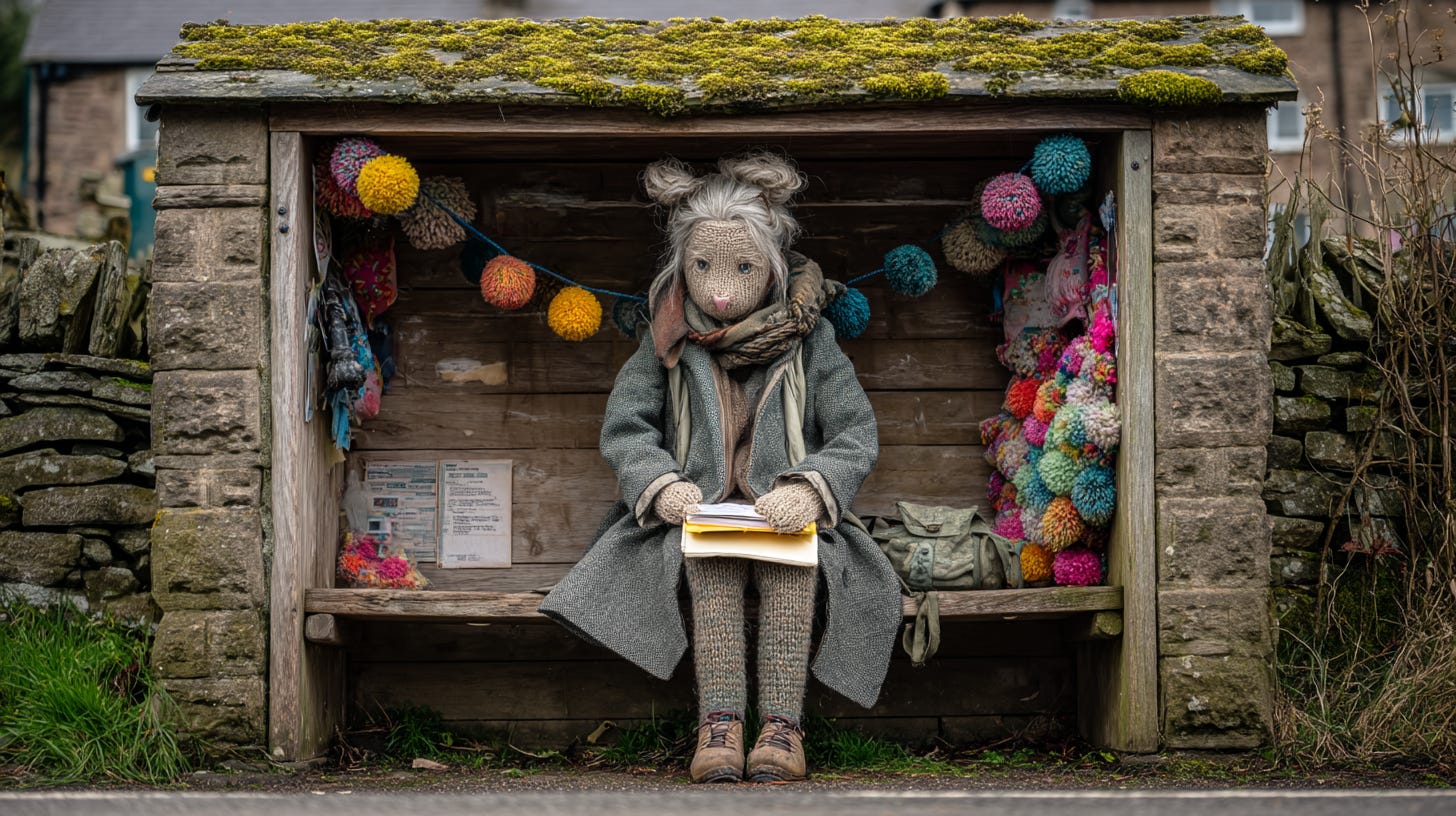I’m just wrapping up my trip home to the UK, where in Devon I kept noticing flashes of yarnbombing — lampposts and post boxes wrapped in wool, bright and a little mischievous. It made me wonder how Lower Tissington might respond if the same thing appeared there. That wondering unraveled into this casefile, with others waiting quietly in the pages of my notebook.
It began, as rebellions rarely do, with a lamppost wrapped in wool.
By breakfast time the post wore a sleeve of striped yarn—crooked, but deliberate.
“Graffiti,” Audrey said, clipboard raised.
“Decoration,” Enid countered.
“Ley lines,” muttered Netta, brushing a tassel against her earrings.
By mid-morning the bus shelter railings were dressed in more of the same: pom-poms tied in rows, a panel of knitted diamonds stretched too tight. Children tugged at the fringe, laughing. Mr. Peale prodded a knot with his umbrella.
“Trip hazard,” he declared.
“Trip art,” Enid shot back.
Then, overnight, the yarn turned figurative. Five unmistakable likenesses appeared in looping rows—Audrey’s cannonball pearls, Reginald’s military neatness, Dot’s pink spectacles, Mr. Peale’s muddied waistcoat, Mrs. Delaney crowned in yellow pom-poms.
The WI called an emergency meeting.
“Defilement,” Audrey ruled.
“Satire,” Enid grinned.
“Heritage,” Netta whispered.
Reginald adjusted his cuffs, voice crisp.
“My thermos has never been red.”
No one corrected him.
The debate unravelled from there. Could pom-poms be defamatory? Was woollen caricature an actionable offence? Should the panel be preserved for posterity, burned for decency, or raffled at the fête?
Enid proposed an exhibition in the hall. Dot wondered aloud about insurance. Mrs. Delaney, faced with her pom-pom crown, insisted she’d never owned anything so frivolous.
Then came the motions. Audrey drafted “Woollen Conduct Guidelines” on the back of the raffle sheet. Enid called for a vote to preserve the panel as “folk art.” Mr. Peale demanded suspects. All eyes swivelled toward Netta. She shrank into her scarf, muttering about ley lines again.
The hall buzzed, words tangling louder than the stitches outside.
Reginald spoke of camouflage and national security—what if critical signage were obscured by wool? Dot fretted it might spread. Mrs. Delaney suggested knitting a rival likeness—one more flattering.
Audrey tapped her clipboard for order, pearls gleaming.
“This village will not be made ridiculous.”
But the yarn already had.
Maggie drifted closer to the panel. She rested two fingers on the knit. The wool yielded slightly, soft where it should have resisted. She pressed again, testing its give, a faint warmth in the fibres as if the maker had only just tied them off.
At the panel’s edge, caught under a fold, one figure was left unfinished—a head bent low, stitches trailing as if meant to fade.
Her hand lingered longer than she meant it to. The murmurs behind her thinned, just for a moment. She caught the scrape of a chair, the sharp click of Audrey’s pen, the faint shuffle of Reginald’s shoes. None of them saw.
She withdrew her hand, quietly, as if pulling free from something alive.
By evening the railings were bare again—Audrey’s decree enforced. Loose wool lay in bin bags outside the hall.
Only a single thread remained, knotted to the bench leg. The dog sniffed, sneezed, and waited. A faint band of colour clung to the paint, as if the stitches had left a shadow.
Maggie bent, tucking the thread back beneath the slat. Not repair. Not removal. Just witness.
The shelter held its quiet; colour gone, argument gone, only the shape of absence left.
Case #23: Unravelled
Observation:Wool wound round what shouldn’t be. Faces in loops. One unfinished. Some watched.
Outcome:Removed before nightfall.



Thanks, Mary! Spending time in lots of small villages over the last month has given me a lot of new material for additional Maggie B. stories. 😊
How delightful, Robert! I especially liked Dot's comment about insurance. True community engagement.